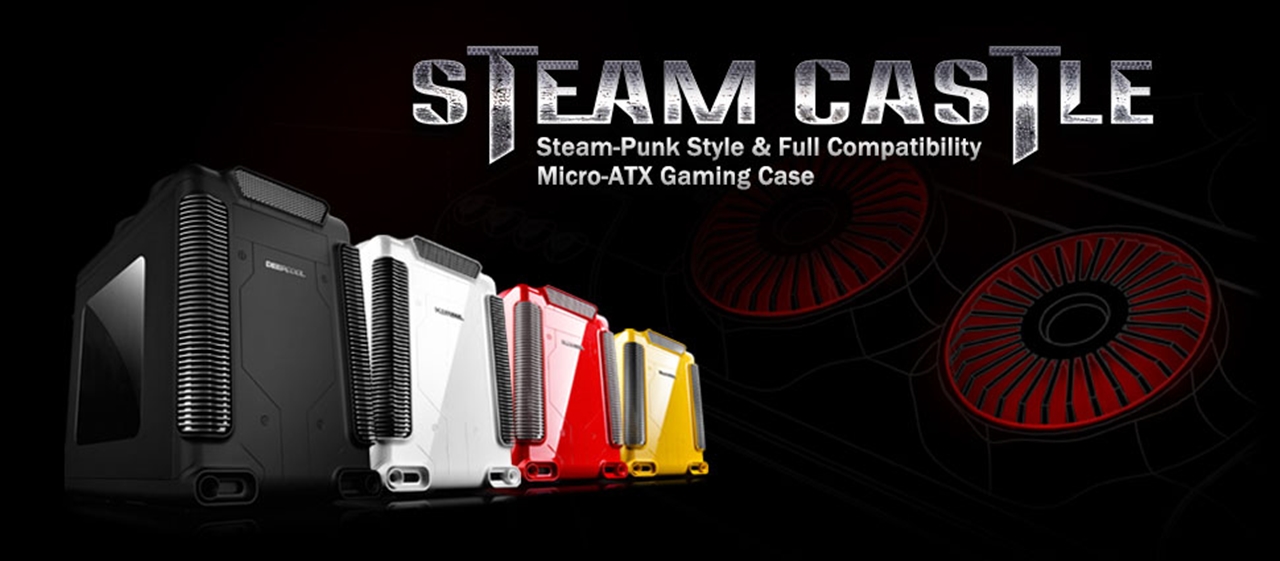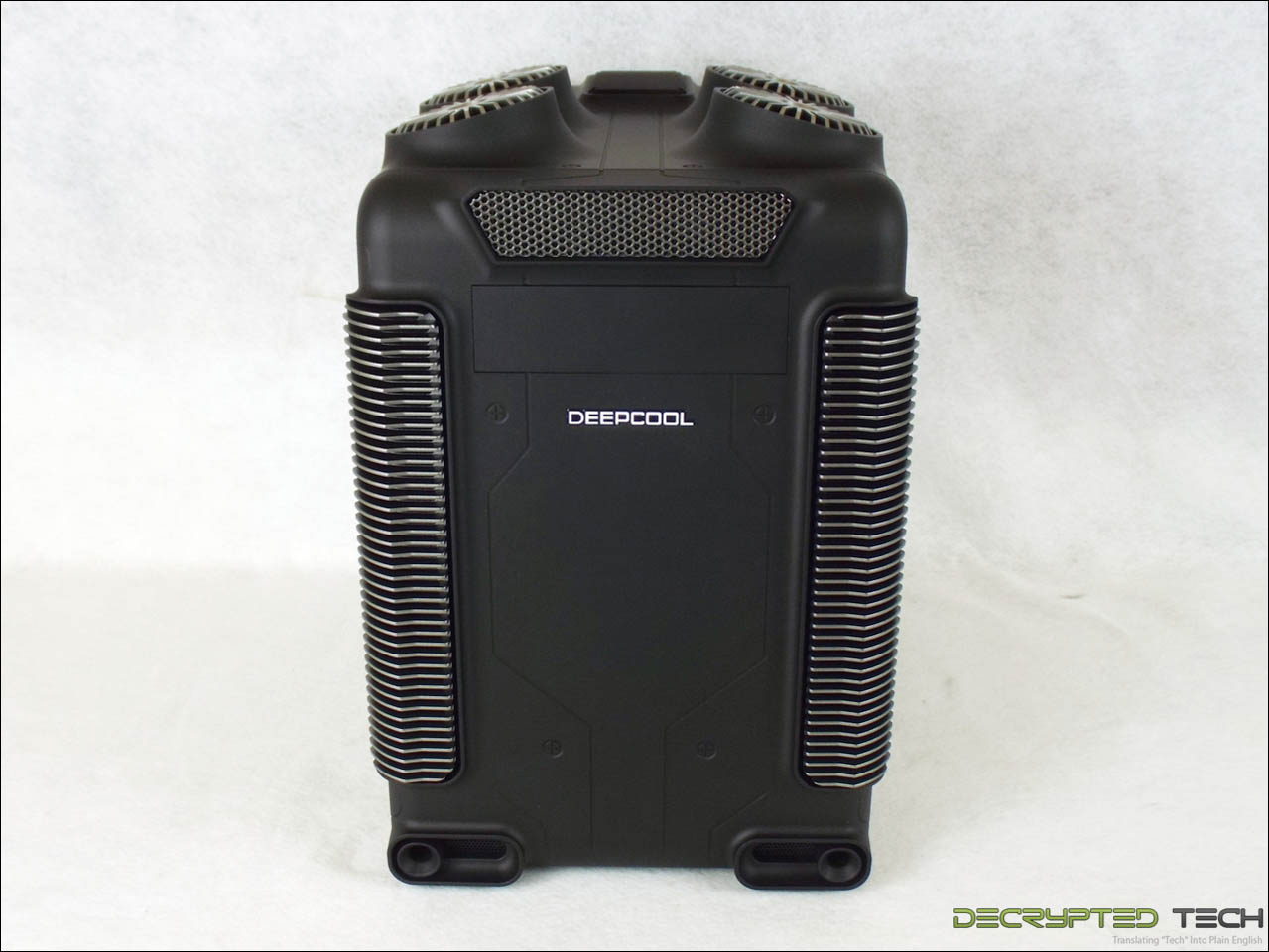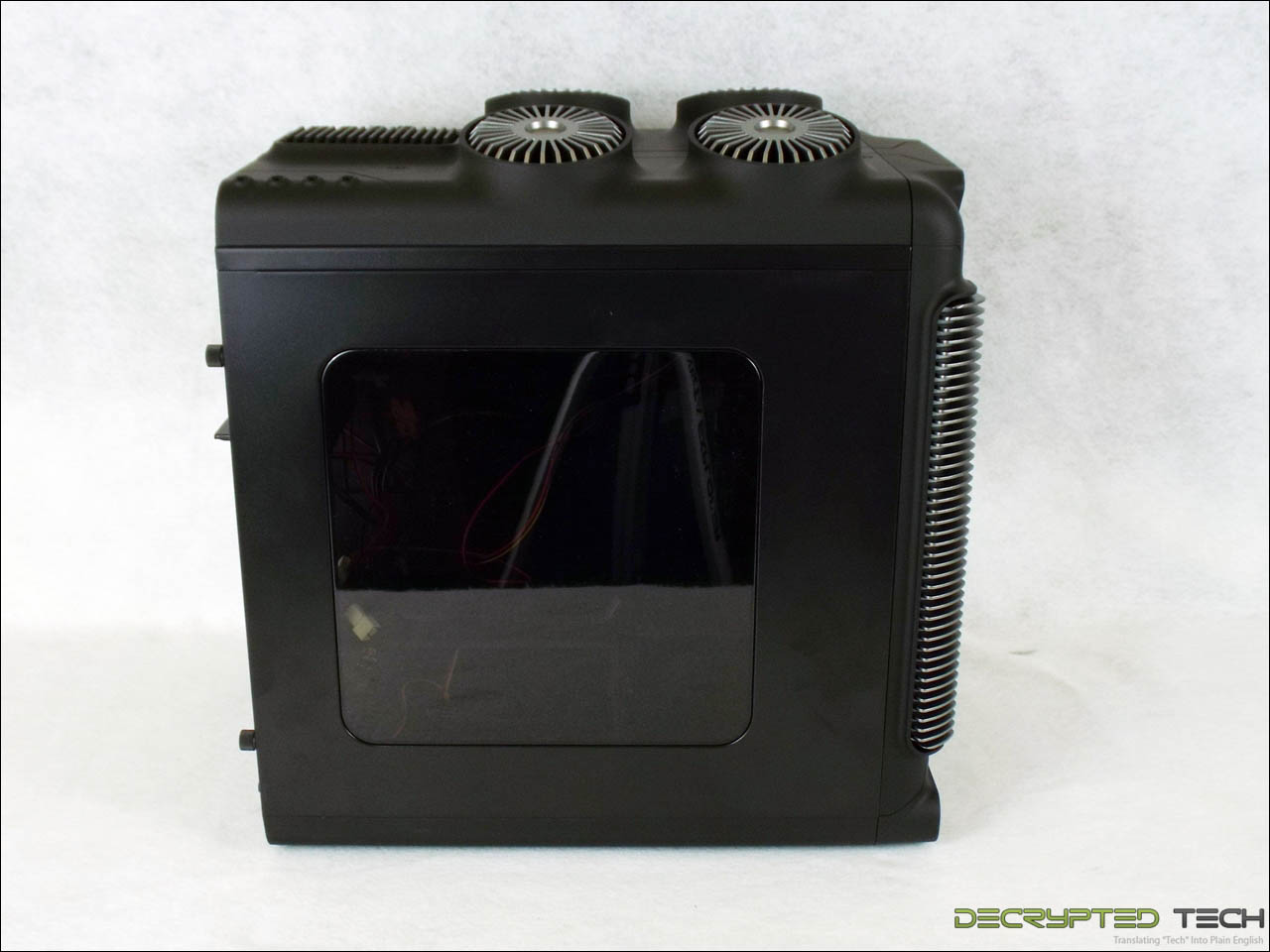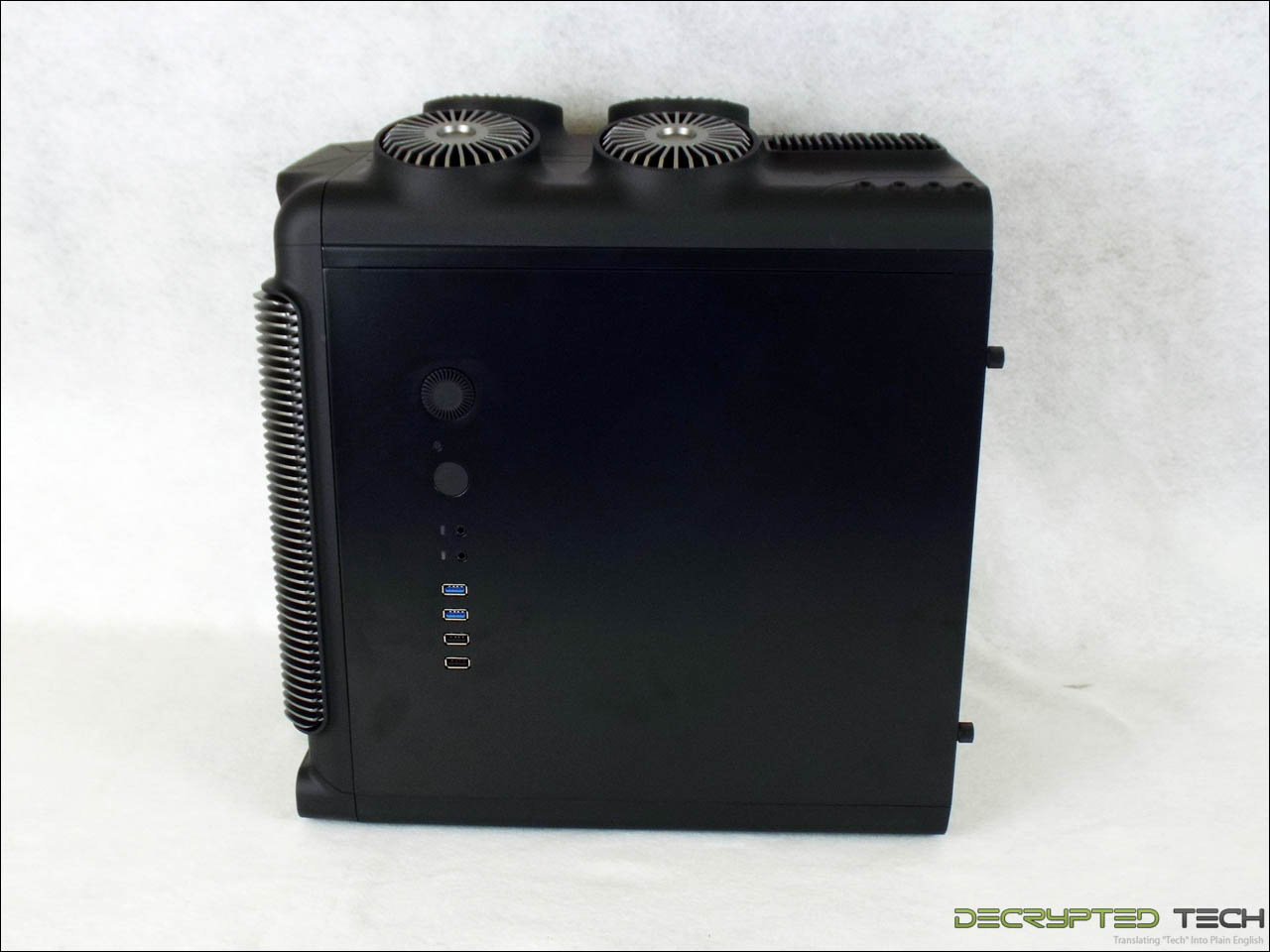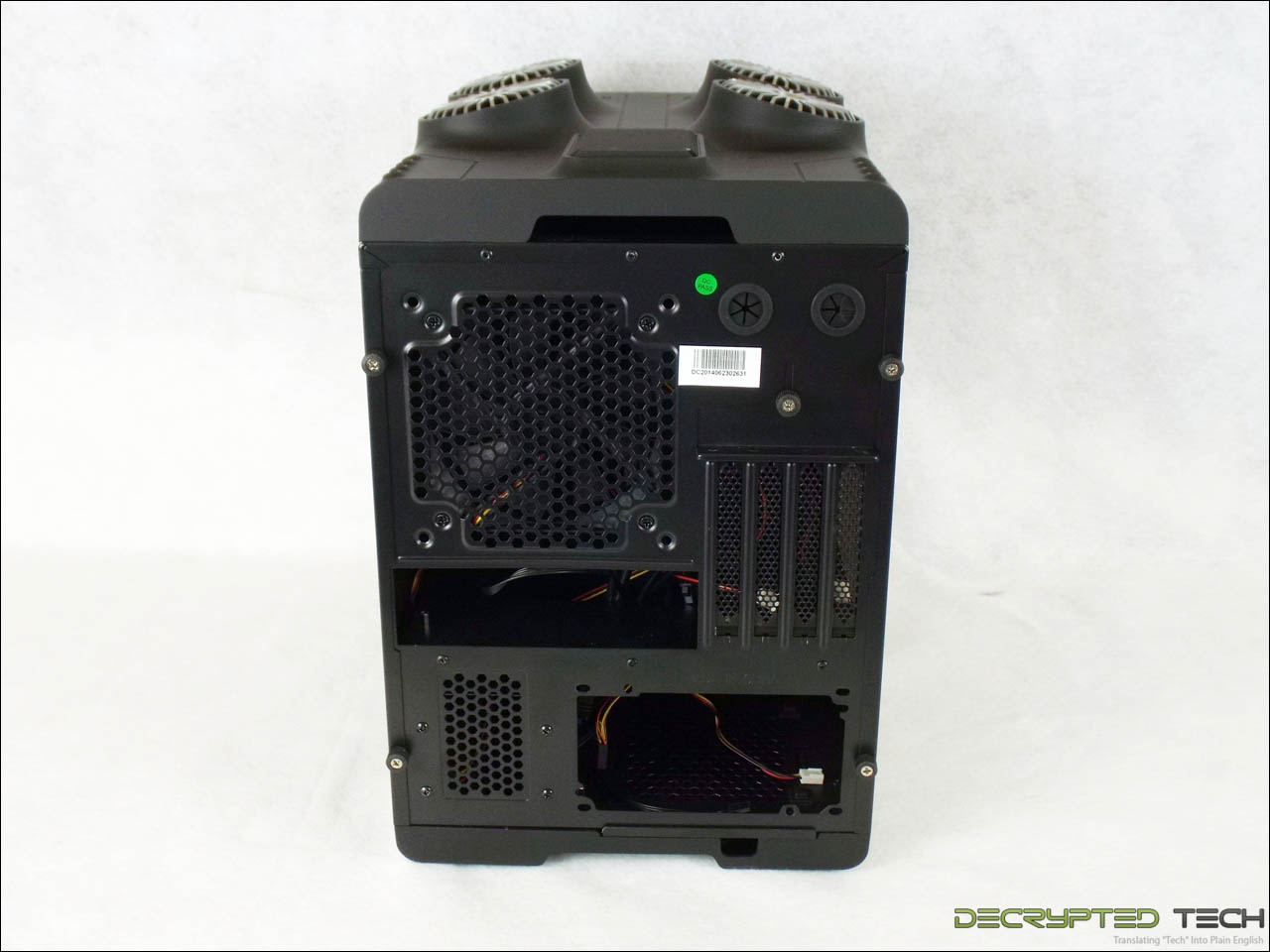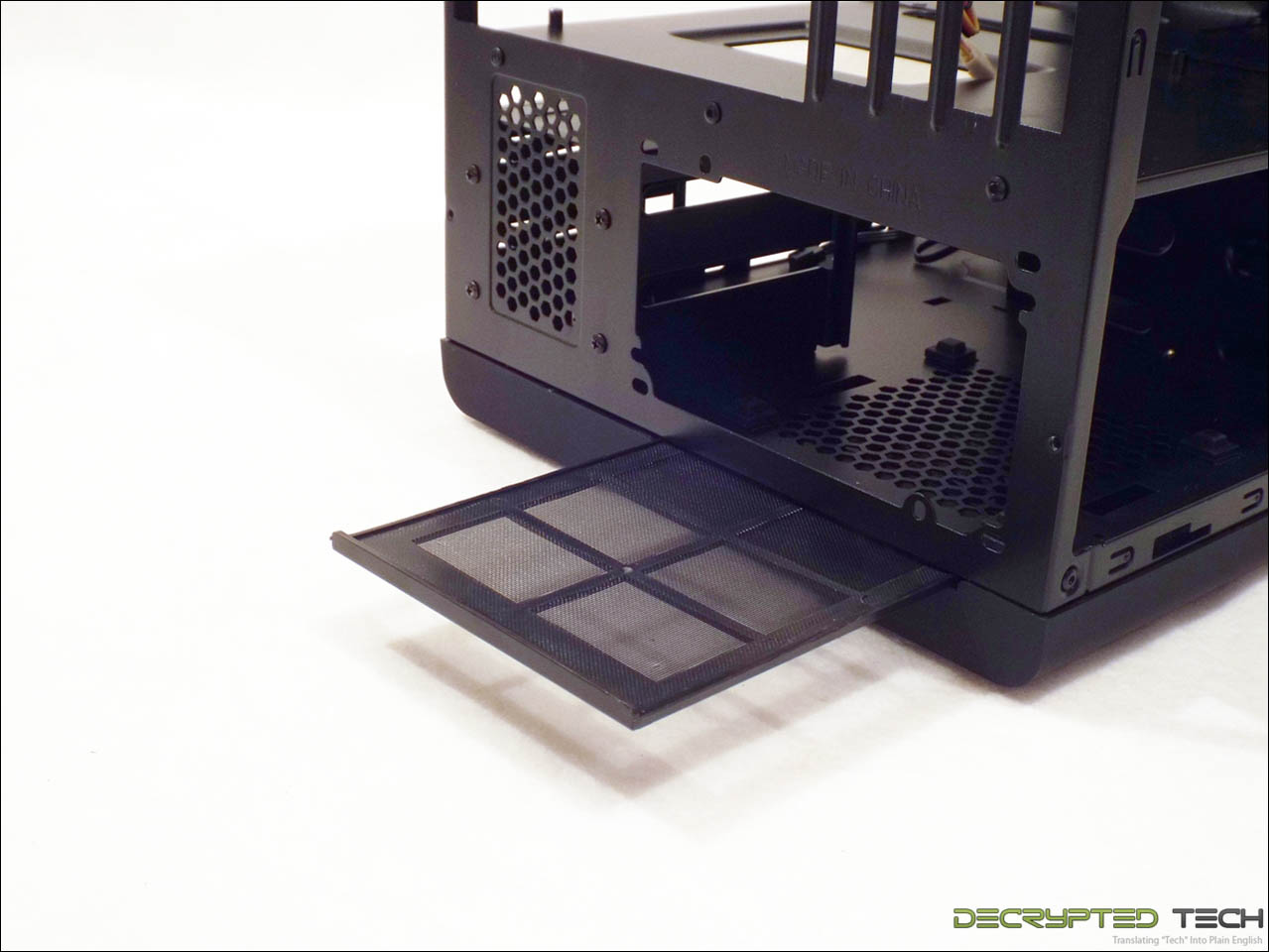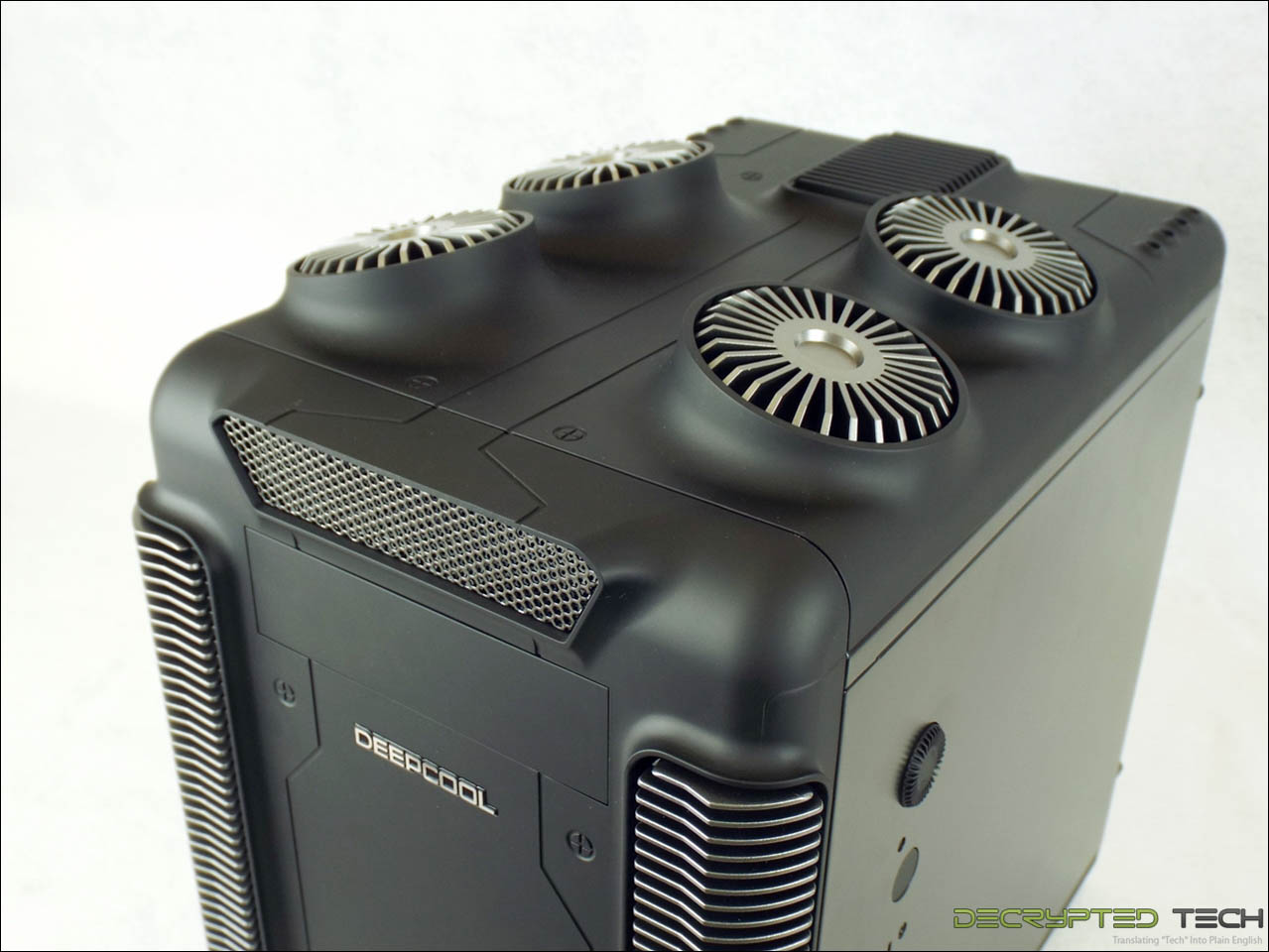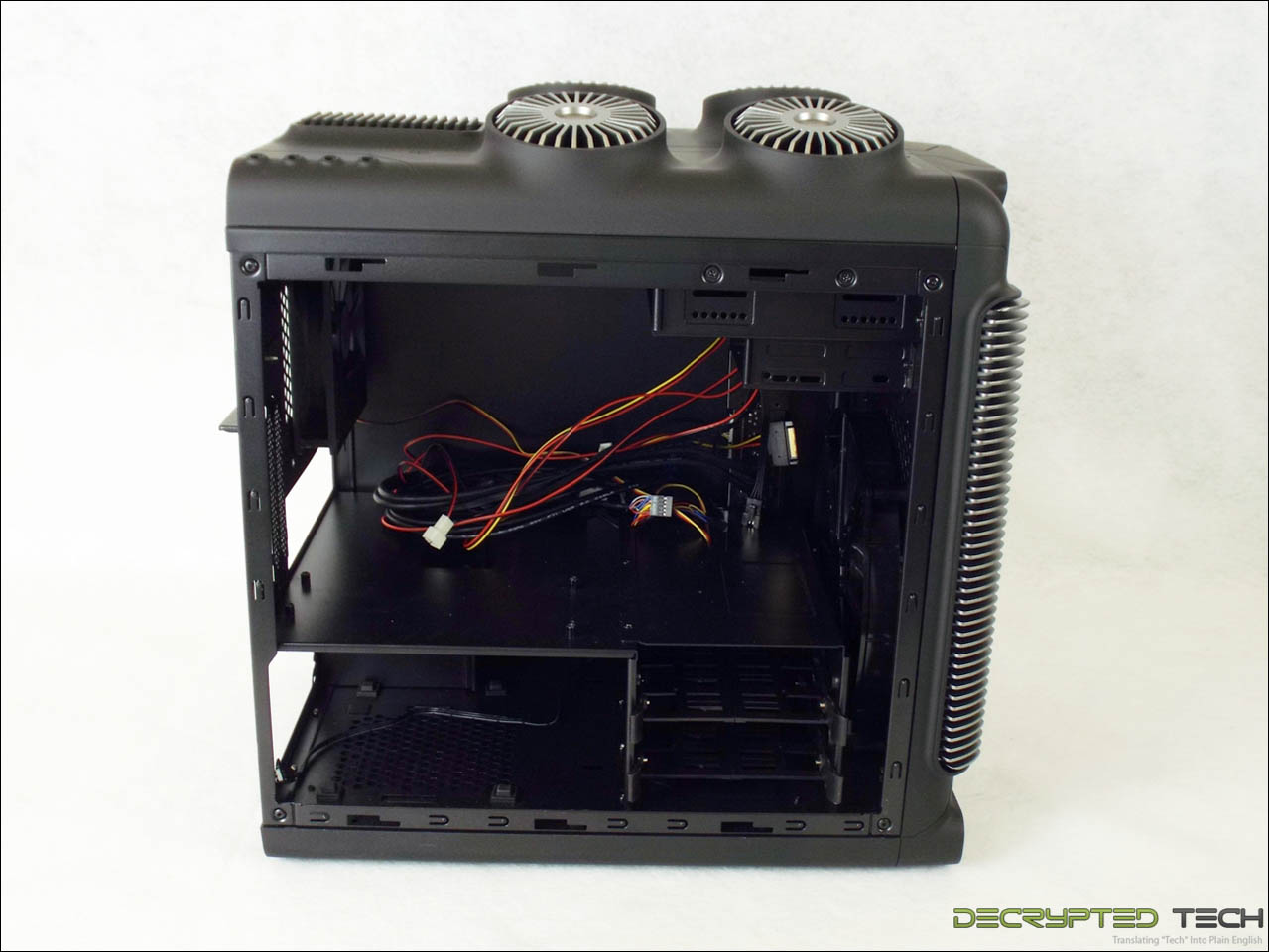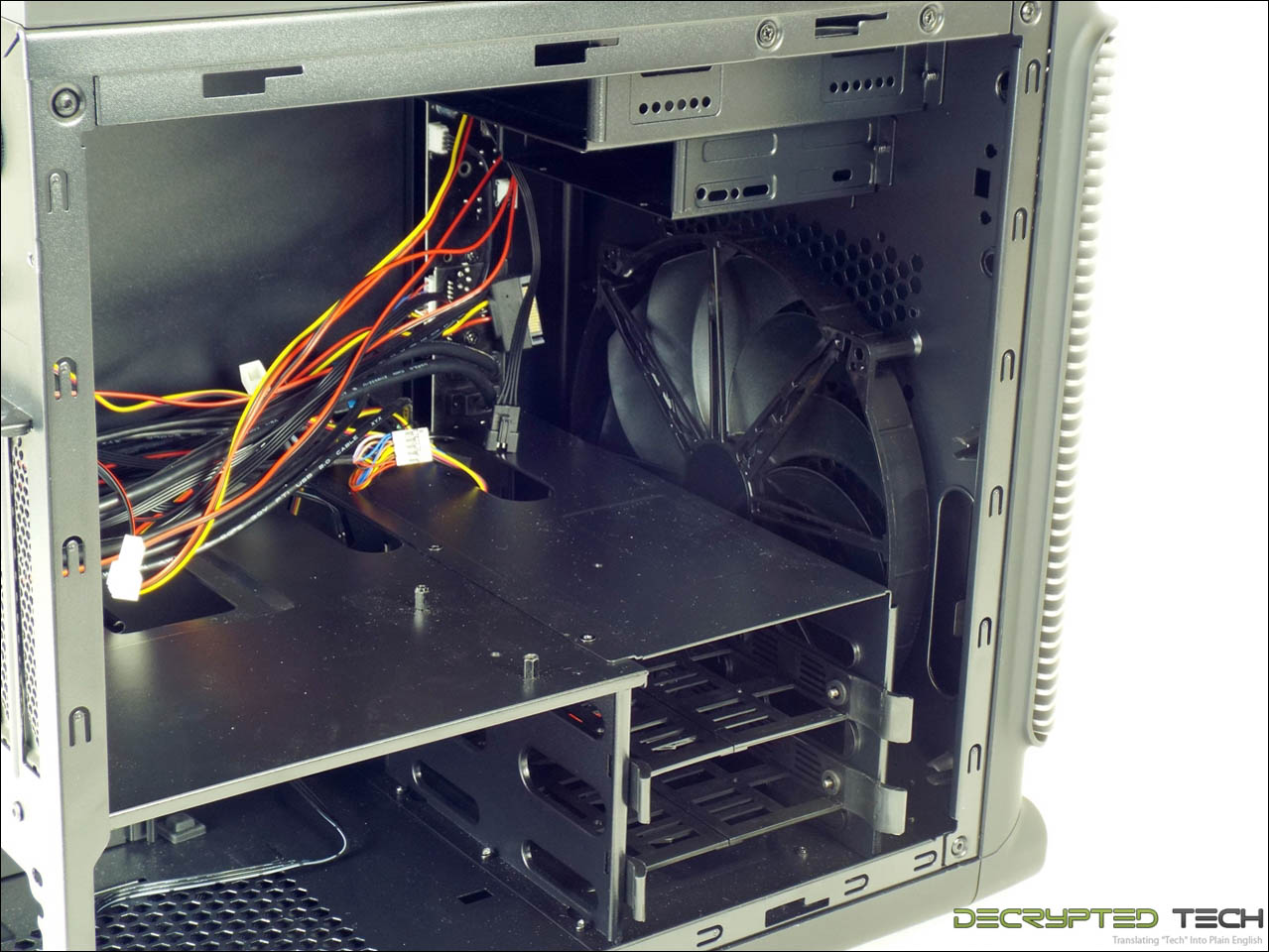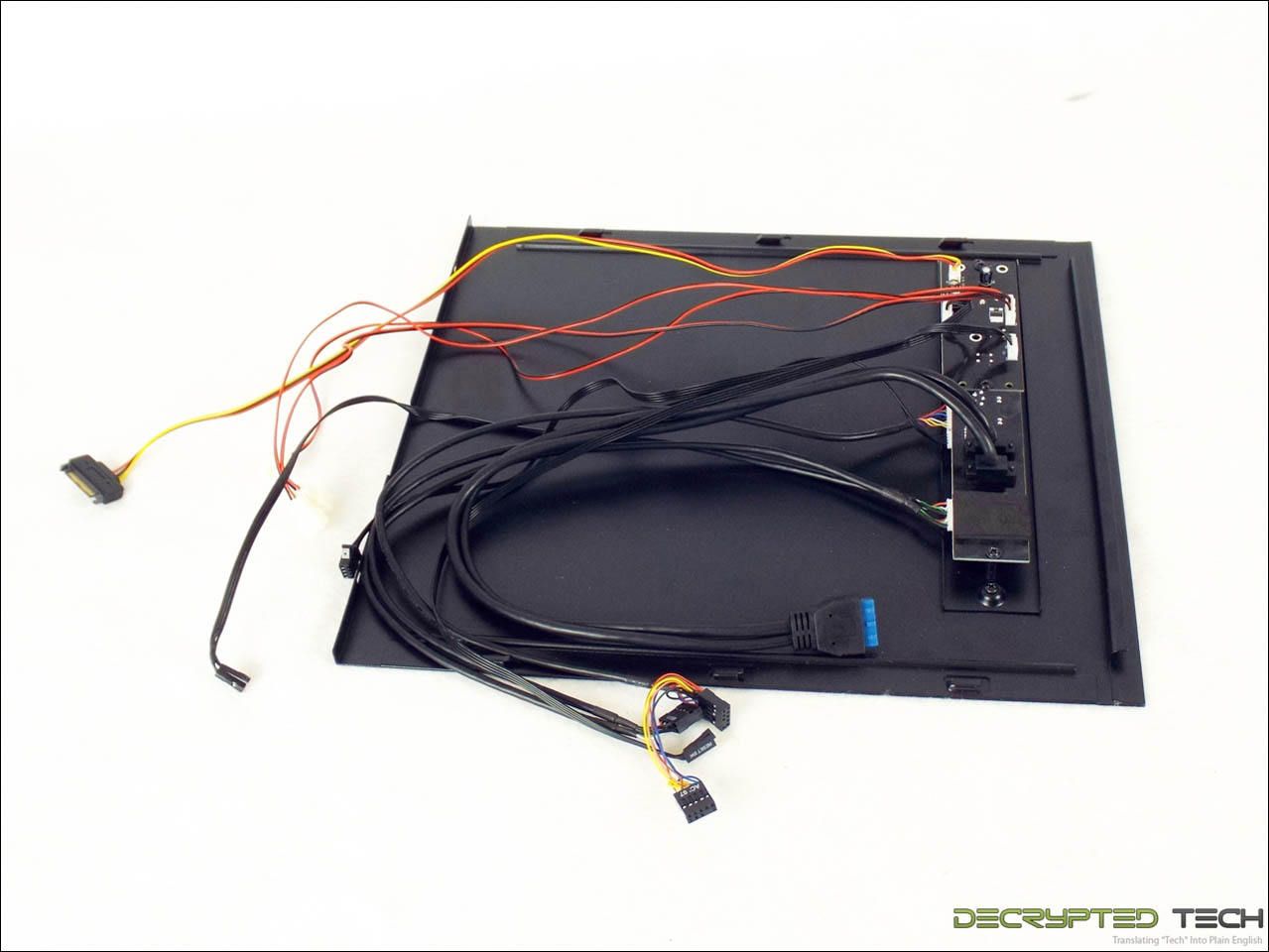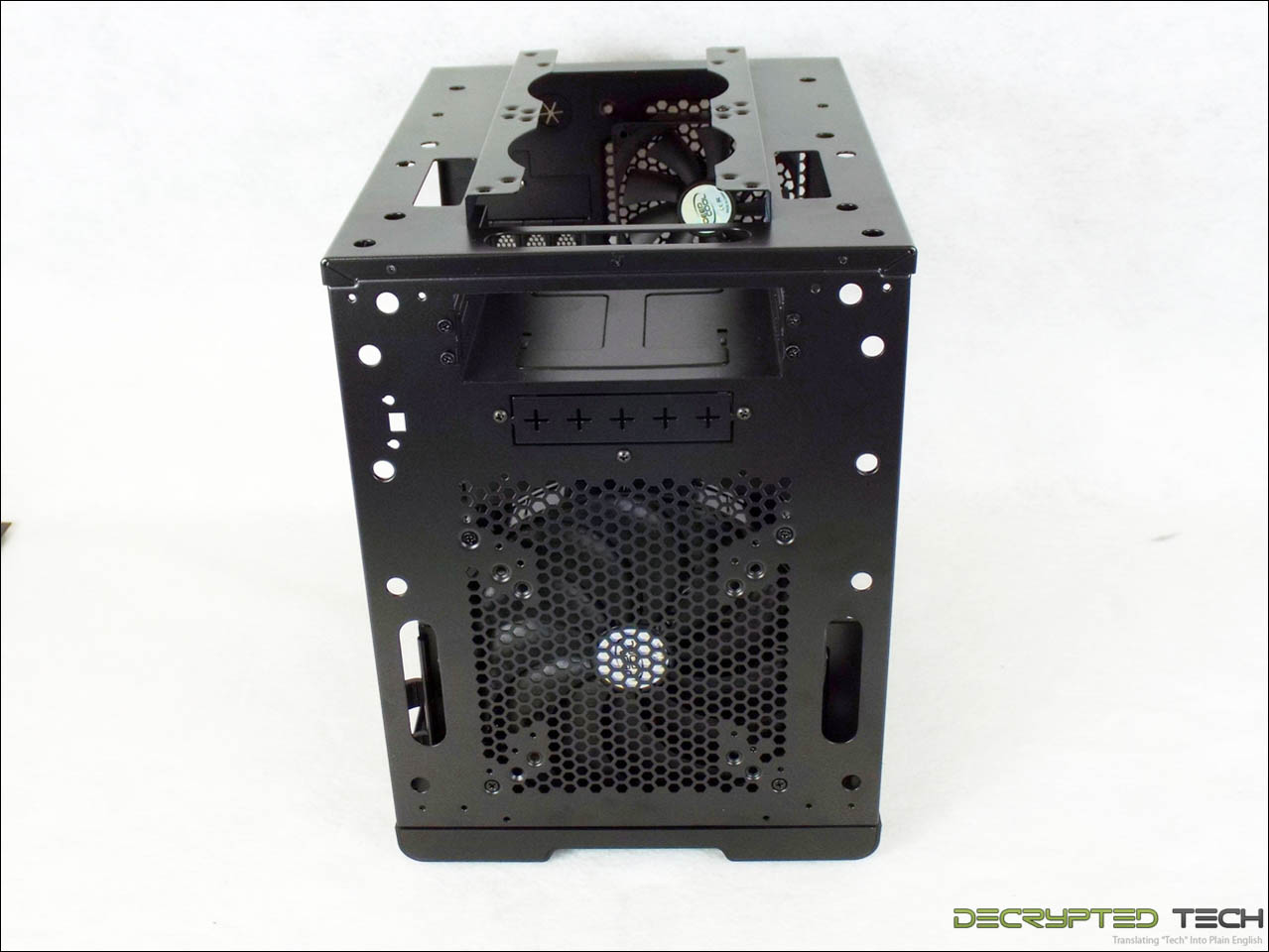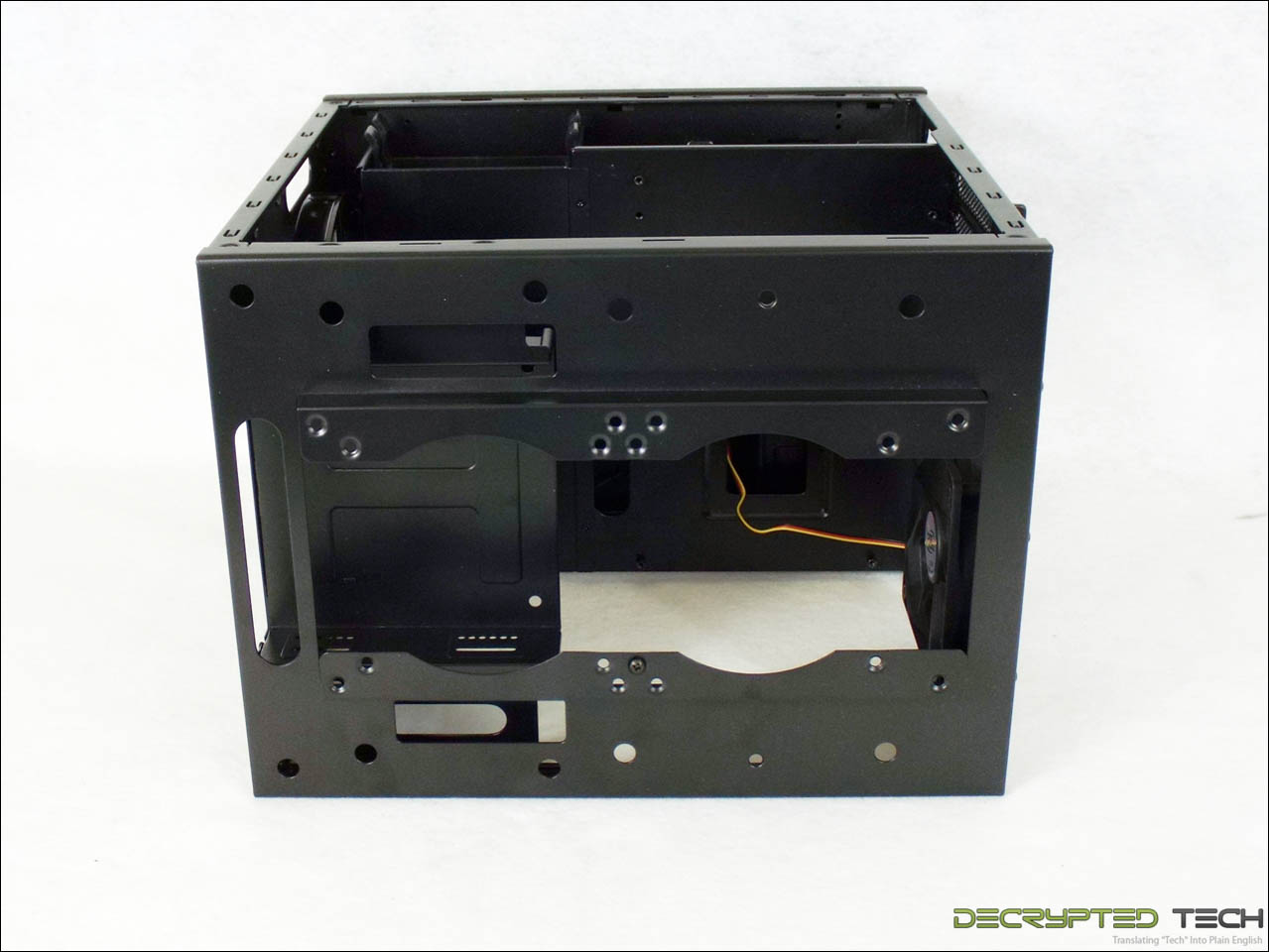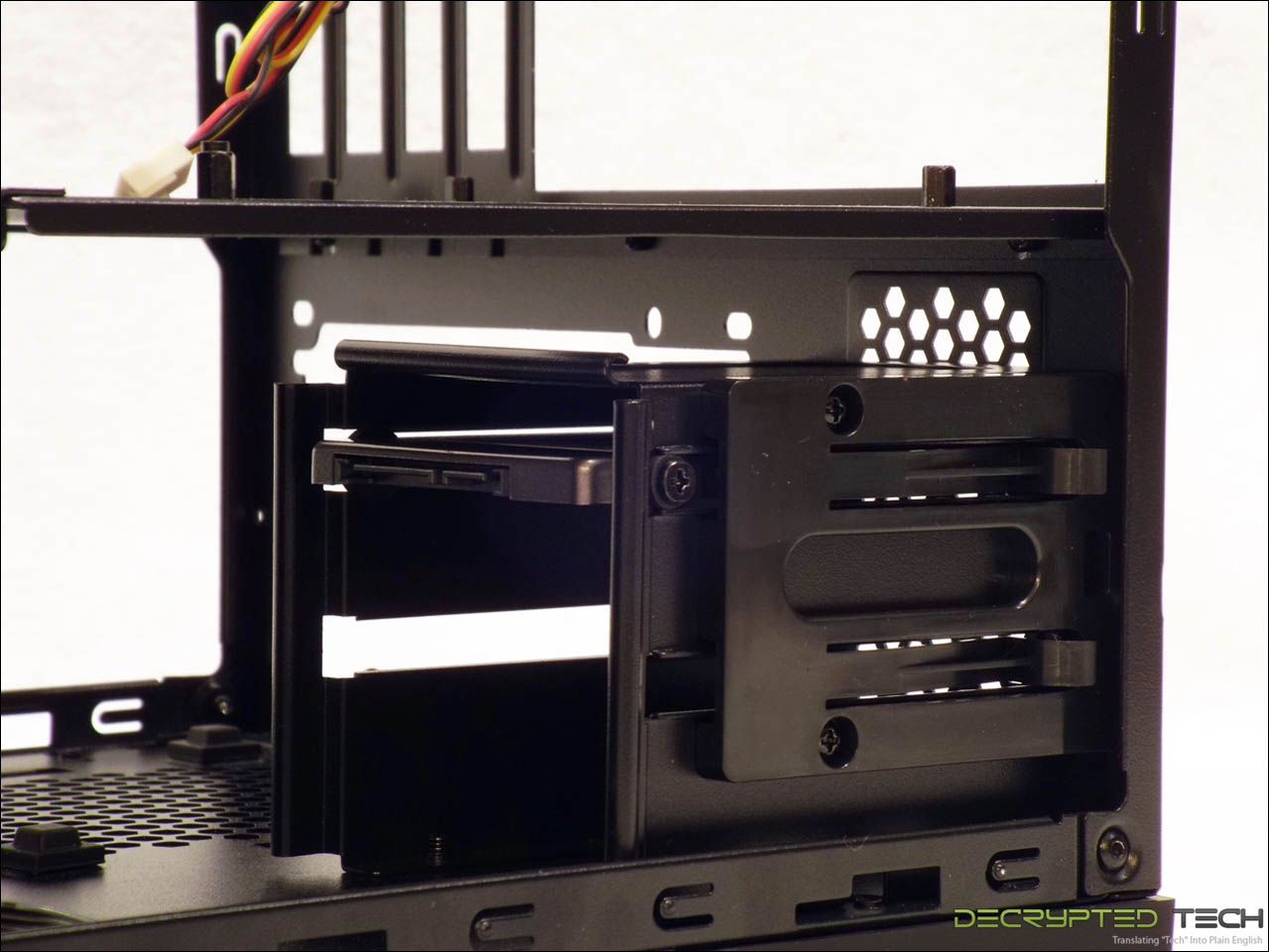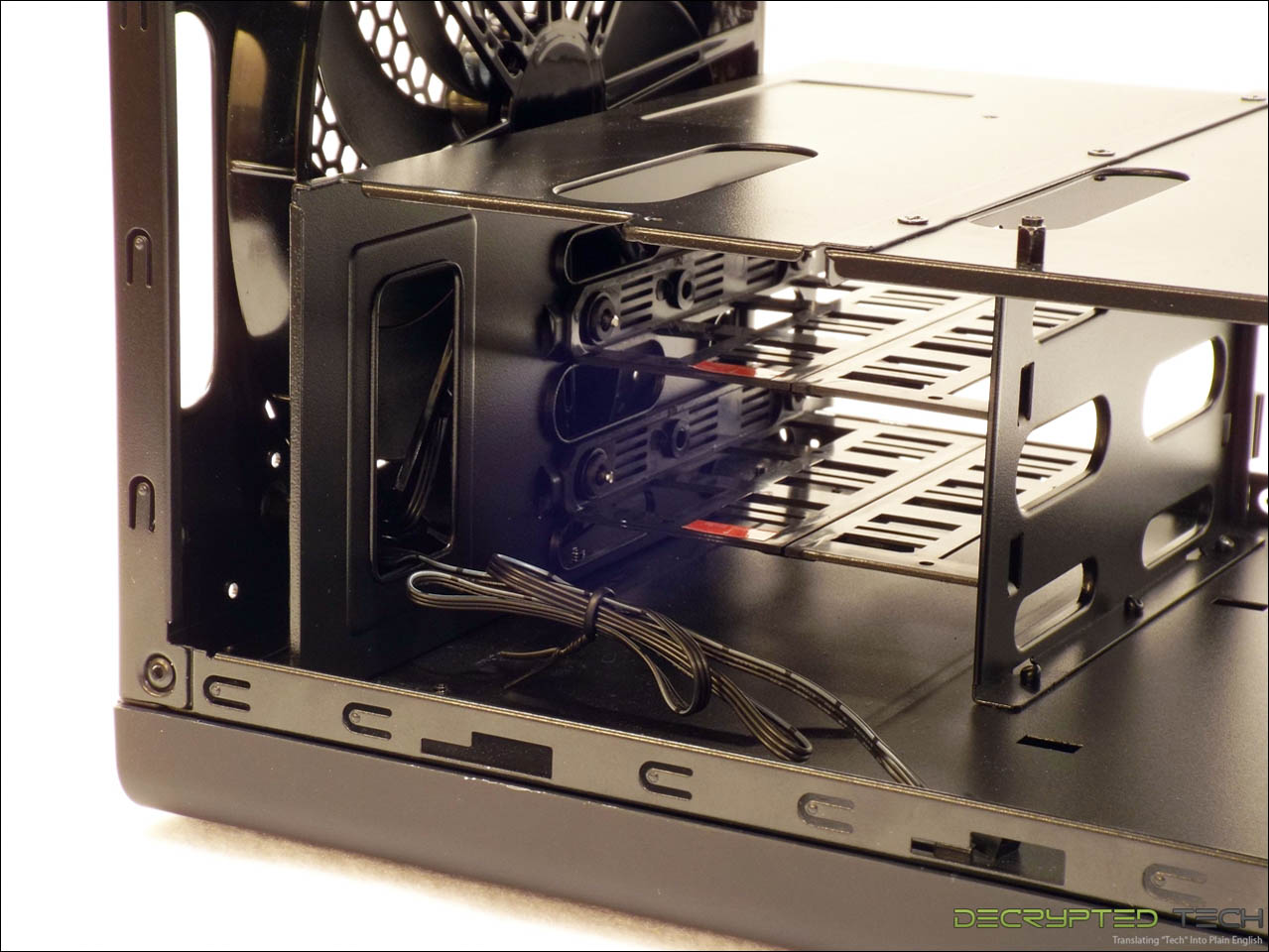There’s nothing wrong with out of the ordinary in and of itself. I’m a modder and believe that sentence wholeheartedly. That said, there’s a big difference between what I might make out of the ordinary for myself or for a client and what a company makes hoping to appeal to the masses and sell in the thousands. Sometimes they come out great, like the Phantom from NZXT or the In Win D-Frame (In Win has been doing a lot of this sort of thing lately). Sometimes they’re not so great. Either way I have to give credit to a company they tests the edges of the market like this, whether I like the product itself personally or not. Today I’m taking a look at one such product from Deepcool, and it has a name as unusual as it’s appearance: the Steam Castle.
I’m a huge fan of the dieselpunk genre (and no, it’s not the same as steampunk), and I have to say that I fell in love with the looks of the Steam Castle as soon as I saw it. It was the black version that caught my attention at first, and I immediately sent an email to Deepcool and requested a review sample. This was one of those products that I enjoyed seeing so much, a risk taken by a company that is still very new to the North American marketplace.
Before I get started with the hands-on review on this case, here is what its creators have to say about it:
“Steam Castle is a dedicated high quality gaming computer case with great compatibility of up to 320mm graphic card installation. Steam punk style bold presentation has made steam castle a unique computer case. Its excellent ventilation performance is contributed by multiple air channels on front, rear, top and bottom panel equipped with a 200mm pre-installed fan provides maximum air flow for heat dissipation.”
Technical Specifications:
Motherboards Micro ATX/Mini-ITX
Materials SGCC+plastic (ABS) (panel thickness .95mm)
Dimensions 406x278x420mm
Net Weight 638Kg
5.25” Drive Bays 1
3.5” Drive Bays 3 (switchable to 2.5”) (2 tool-free installation)
2.5” Drive Bays 2 (tool-free installation)
I/O Panel 2 x USB 3.0/2 x USB 2.0/Audio x1/Mic x1
Expansion Slots 4
Cooling Fans Rear 120mm
Front 200mm
Power Supply Type ATX PS2 (max 160mm length)
CPU Cooler Compatibility Max 200mm height
CVA Compatibility Max 320mm length
Packaging:
The Steam Castle showed up in a fairly simple brown box with a picture of the case and general specs on it. This sample came all the way from China to my door, a sure test of any packaging. Upon opening it and examining the contents, I was surprised to find one of the internal mounting studs for the control panel broken off. With no damage to the box in that area this was no fault of the packaging, but likely a simple casting defect. To their credit all it took was a single email to Deepcool to report the problem and a new panel was at my door inside a week. Your mileage may vary, but that kind of customer service is hard to find in my experience.
Exterior:
Before we start with the pictures I want to look at the word “steampunk”. This word has been overused even more than blue LEDs. It’s become synonymous with anything remotely resembling what it once was. Personally, I see nothing “steampunk” about the Steam Castle. As a fan of steampunk from long ago, this is dieselpunk. For those who fail to see the distinction, I assure you it’s there. Wooden-bodied airships with copper filigree and brass gears and cogs? Steampunk. Iron trains with art deco curves, rivets all over the place and colors ranging from black to gray? Dieselpunk. One of the best way I’ve heard the difference described was to say “dieselpunk is steampunk with internal combustion”. Also, “industrial deco” comes close. But I digress. Suffice it to say the style of the Steam Castle is squarely in the dieselpunk genre, but “steampunk” is better known and likely makes more sales.
Getting the case out of the box, I was immediately surprised at its size. I knew it was a micro-ATX case, but I hadn’t seen any images of it with anything else to put it in context, and its form makes it look larger than it is. This is definitely not a con. The surprise was a pleasant one.
At first glance, even across a room, it’s clear that the Steam Castle is a different animal. Nothing I’ve seen looks like it. From the protrusions on its top to the very cool grill stacks on the front corners, right down to its satin finish, this case screams different. From the front the single external 5.25” bay can be seen, but only by its outline. This is one of the cleanest joints I’ve seen in a bay cover, blending in seamlessly with the cosmetic lines below and above it. I wouldn’t put an optical drive in this case without a stealth cover. More on that in the modding section. The stacked grills on the corners are actually functional air intakes also, not just window dressing.
Looking at the left side shows the acrylic window. While it’s not as large as many I’ve seen taking up most of the side panel, that’s probably for the best in this case given the internal layout. The size and shape of the window will serve to show off most of what the enthusiast likes to show off while allowing enough solid panel to hide cables. I was a little disappointed to see the large plastic-head thumb screws that were used to hold the panel in place, but with standard threads, better-looking screws are an easy and inexpensive mod for those who want it.
On the right side can be seen the control panel I mentioned earlier. Input/outputs include power and rest buttons, two USB 2.0 and two USB 3.0 ports, headphone and microphone output and a single knob/button that controls fan speed and the color of the LEDs mounted in those eye-catching upper ports. Press this button to change the colors, and turn the knob to increase or decrease fan speed and LED brightness.
I was a little put off by the placement of this panel. It’s completely counterintuitive to me, since the user will normally have the window side of the case facing them. That’s why most manufacturers put the controls on the top, front or left side. It’s clear that it was done for aesthetics, to keep that incredibly clean look on the front of the case, and I can appreciate that. Whether I appreciate it enough to warrant reaching to the other side of the case every time I need to use the panel or not is another story. Myself, I would use a USB hub for input and turn the system off with my keyboard. Is it worth it for the look of the Steam Castle? That’s too subjective to say here.
Around back we finally start to see some of the standard things we’re used to in a case. The I/O panel cutout, 120mm/140mm exhaust fan mount, PSU mounting area and four expansion slots are fairly standard for any micro-ATX case, though of course arranged for a horizontal application. There are even the usual holes with grommets for hoses for an externally-mounted radiator.
The Steam Castle has an easily removable air filter for the PSU intake, allowing it to be removed for cleaning without having to tilt the case at all.
 |
 |
The expansion card retention system is very easy to use, consisting of a hold-down plate with a single thumb screw. Loosen the screw, lift the plate, install the expansion card, lower the plate and tighten the screw. Altogether simple and secure, one of the simplest and most effective systems I’ve seen. While it likely wouldn’t be as effective in a full-ATX setup, or in a vertical orientation, implemented in this case it’s fantastic. While this isn’t the first case to use this setup it’s welcome regardless.
Turning the Steam Castle on its side gives us a clear view of the most unique feature of this case: the top. It’s obvious that the four vents are meant to be seen. They fairly shout to be seen in fact. They’re even illuminated to be seen. They are without a doubt the focal point of the overall design of the case. Like many people, at first I assumed there were fans inside these vents. Alas there are not. Looking at it firsthand though, that’s likely a good thing. Four fans this size, turning fast enough to be effective would likely be very loud.
Even without active air movement they are large enough to provide adequate ventilation, especially when coupled with the rear vent in the center of the top panel. These protrusions are another area just begging to be modded into something more than their creators intended. We’ll look a little more closely at these in the Modding section as well.
Interior:
Ok, holding things up again here. When we pull off the molded panels on the Steam Castle what we’re left with may well be familiar to some. This case is built on the exact same chassis as the Aerocool DS cube and the Xigmatek Aquila. While the Aquila omits the 200mm intake fan and the 3.5” bay mounted beneath the 5.25” bay, the Aerocool DS is identical. The fact that these other well-established companies use this same chassis for their product speaks well of its practicality, but we’ll see how it works out first hand.
Removing the left-hand panel shows the entirety of the interior of the steam castle. The motherboard tray sits above the PSU and hard drive areas and is not removable. The cluster of cables seen here comes from the control area on the right-hand side panel. Black sleeving would have gone a long way toward improving its appearance.
A different angle and a little more light shows the included 200mm intake fan. Though the fan in the Aerocool DS case is labeled with their brand this is the exact same fan, down to the shape of the bracing and the notches by the mounting screws. This fan is extremely quiet, even when forced to draw its sir in through the tall narrow intakes on the Steam Castle.
Taking the right-side panel off gives us a better look at just how large that cables cluster is. With cables for all of the inputs listed earlier, plus a SATA power connector and three 3-pin fan connectors, there’s a lot going on in a very small area here. In a chassis this small cable management is always a challenge but when this many of the cables are attached to a panel that is designed to be removed it makes it a lot harder.
Fully stripped to its basic chassis, we get the first look at the upper mounting area. This can hold two 120mm fans, two 140mm fans, or a single 240mm radiator. Note that to use a fan on the frontmost half of that radiator both the 5.25” and 3.5” upper bays must be removed.
A better look at the upper mounting area.
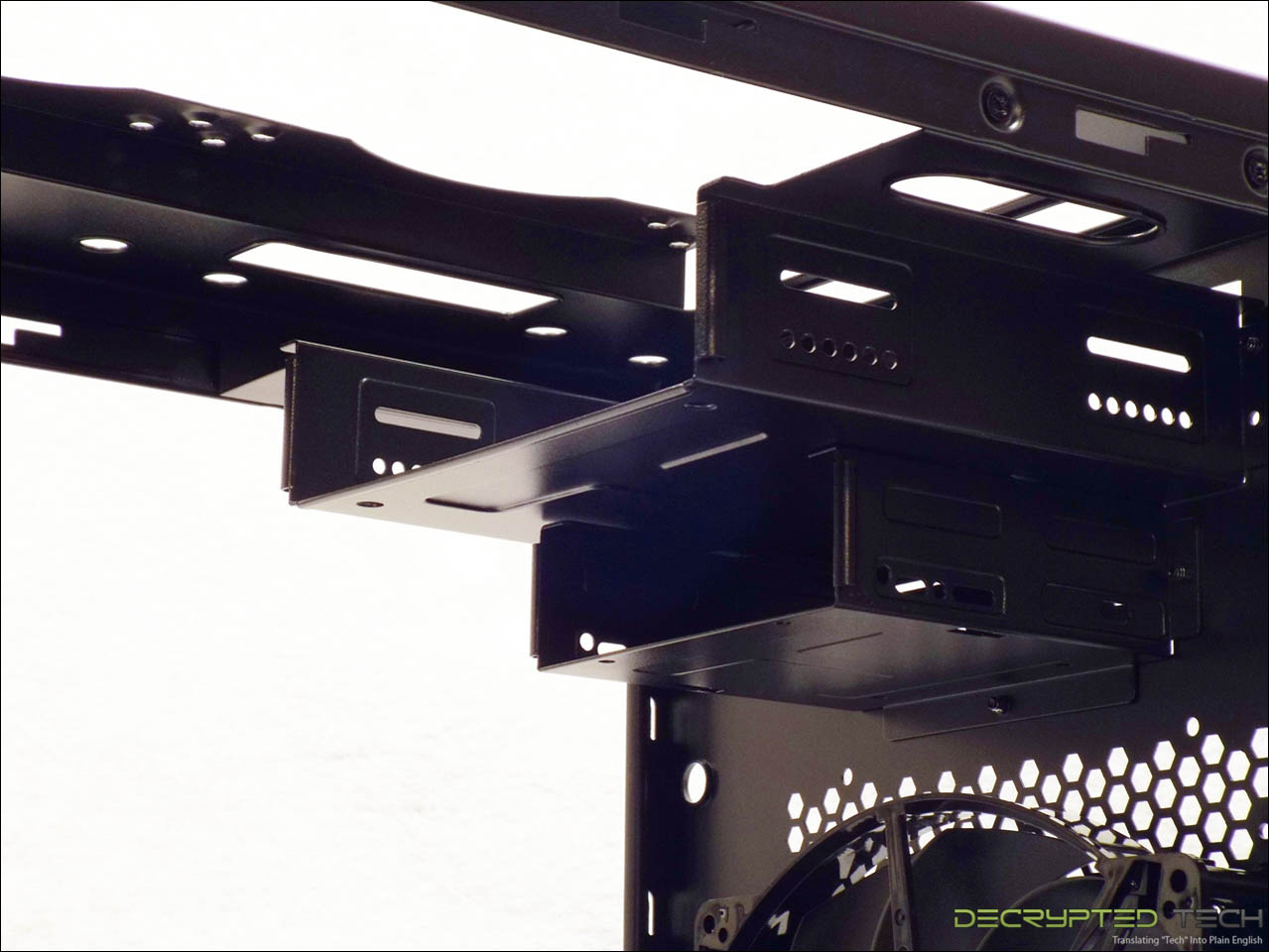 |
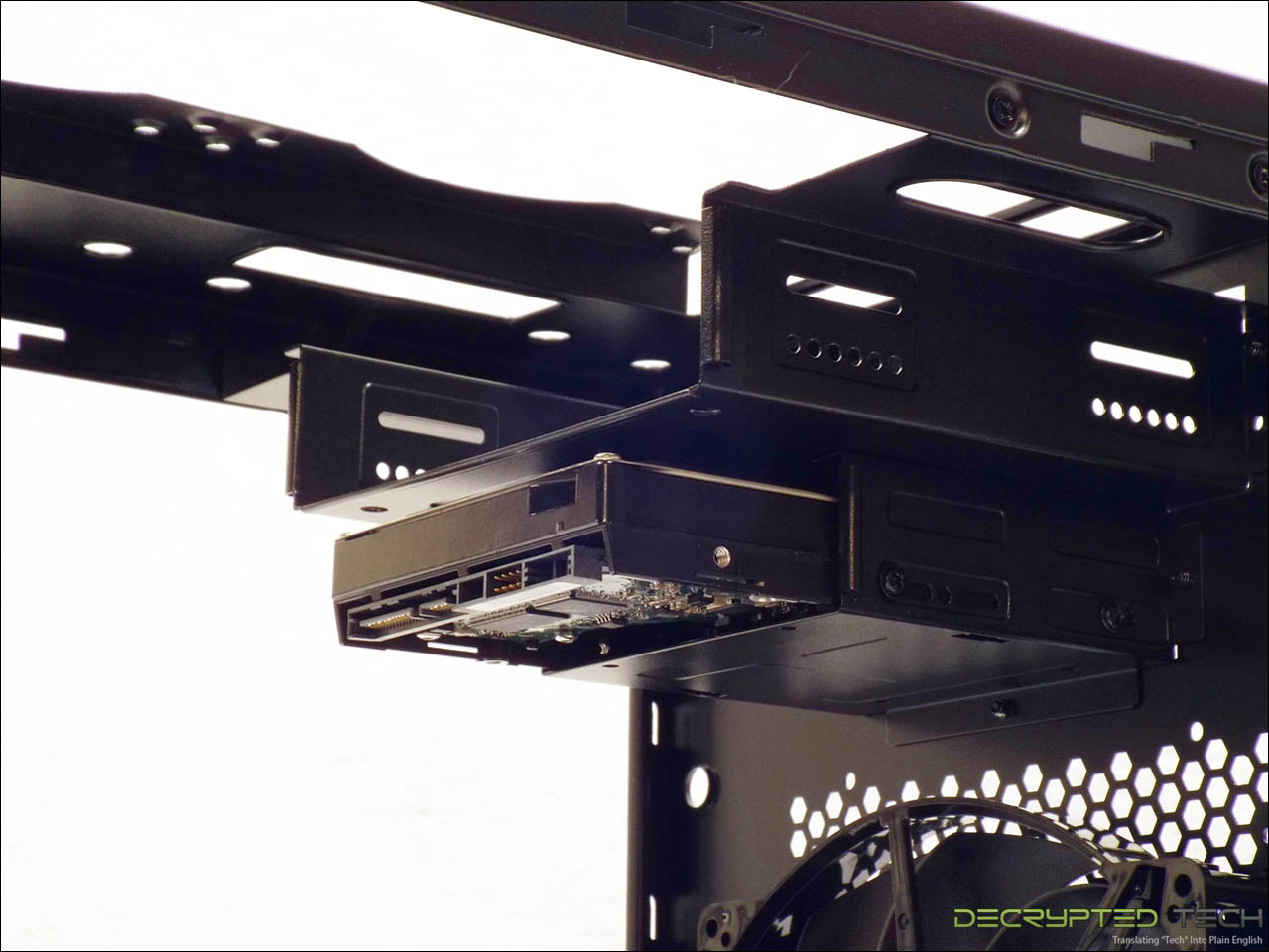 |
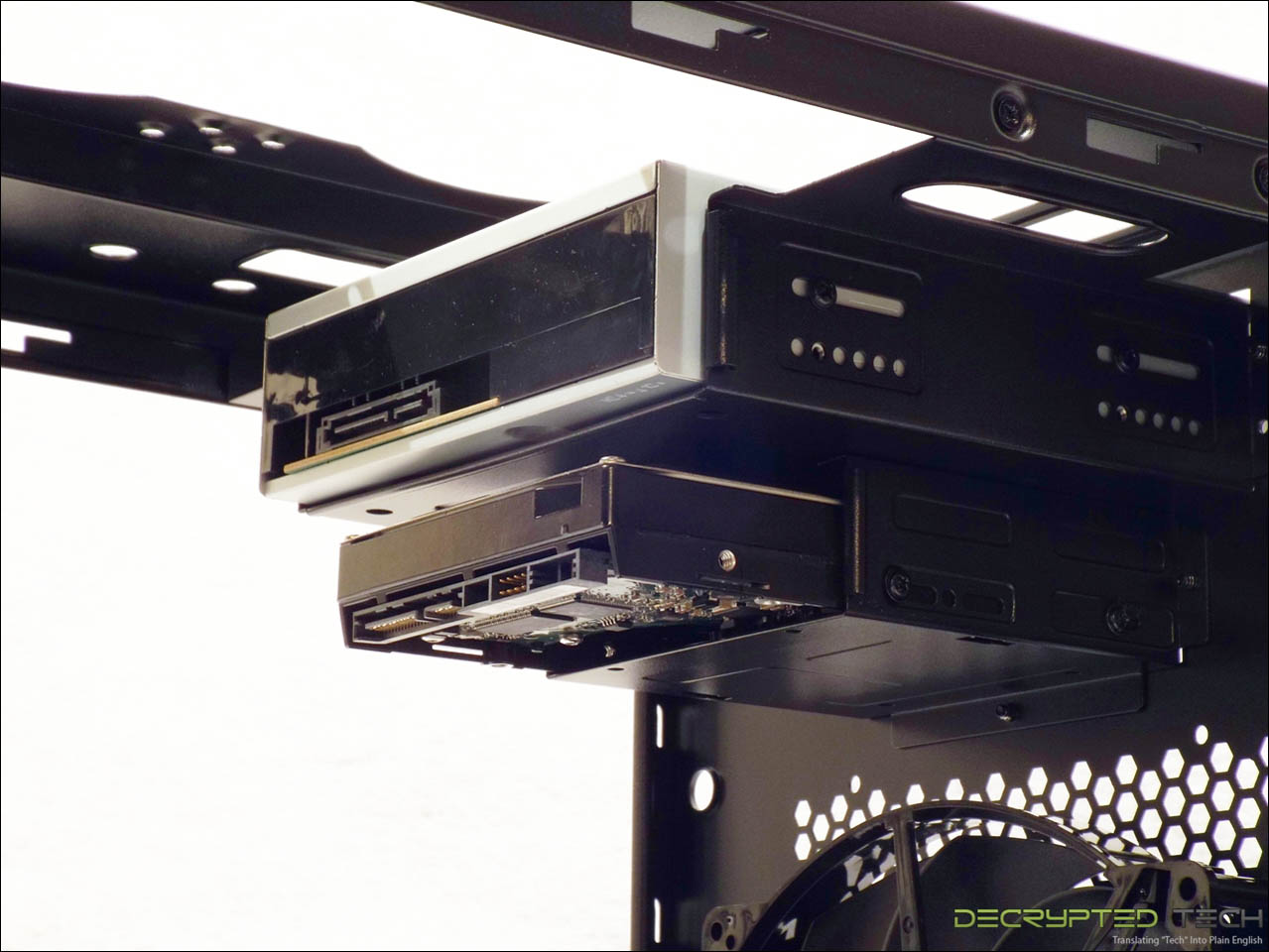 |
The internal 3.5” and 5.25” bays are easy to get to and easy to install hardware in. They are also easily removable. The 3.5” can be removed on its own, if the larger bay is to be removed they both have to go.
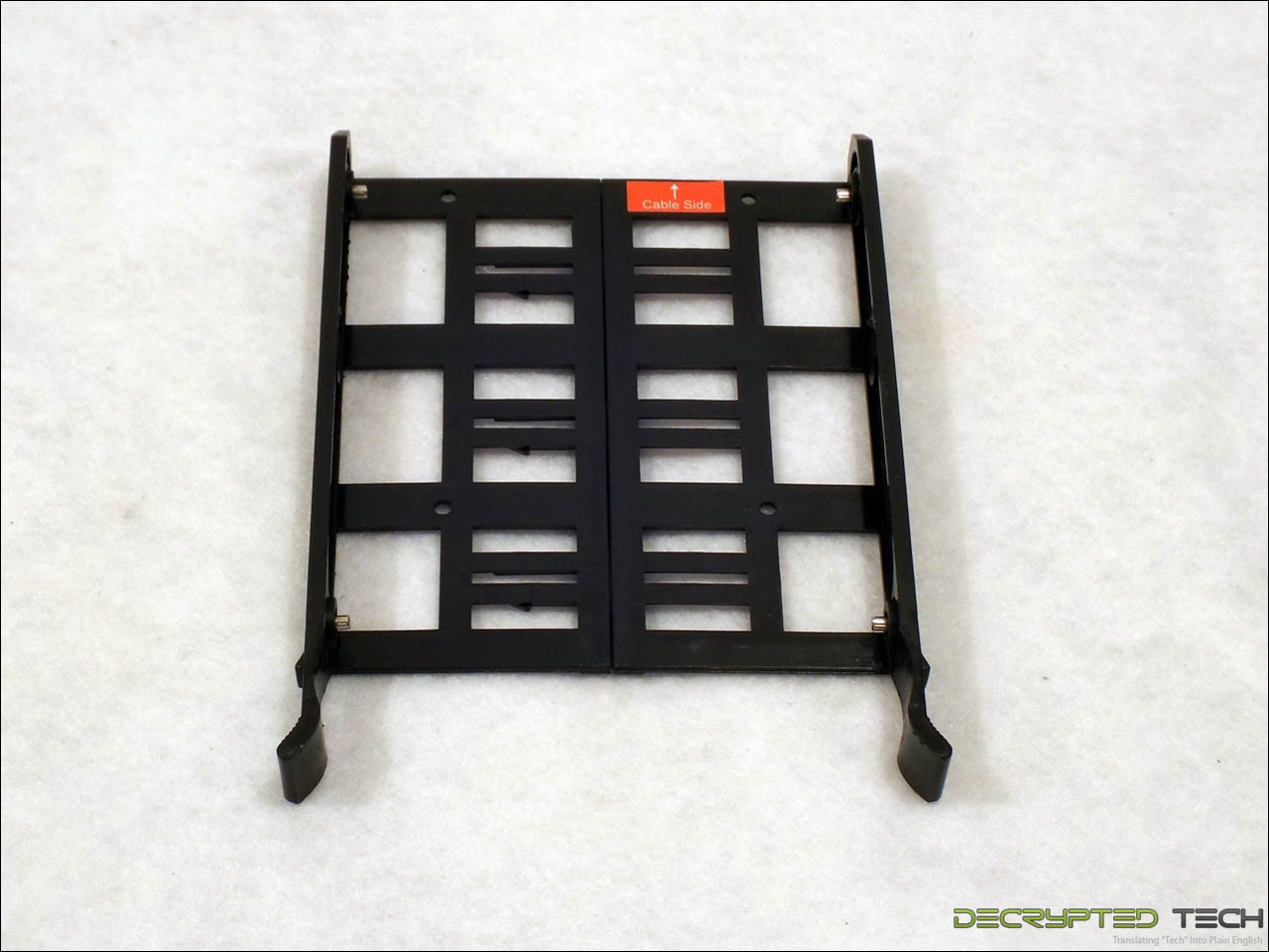 |
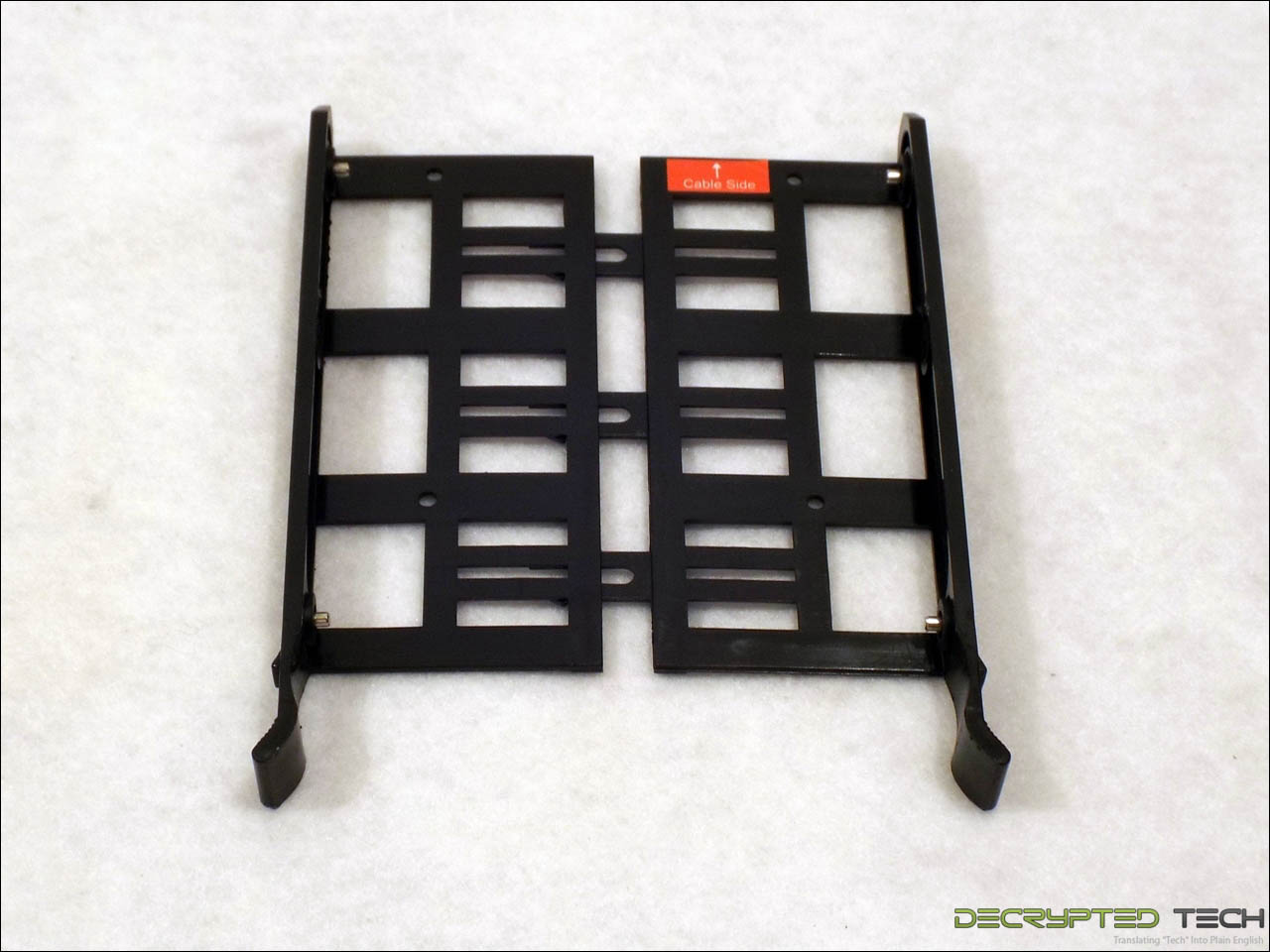 |
 |
Hard drive mounting is done with tool-free expanding cradles that click in place in the front bay. Two 3.5” can be mounted here in this fashion. Each cradle will also accommodate a 2.5” drive, though they have to be installed from the bottom with screws.
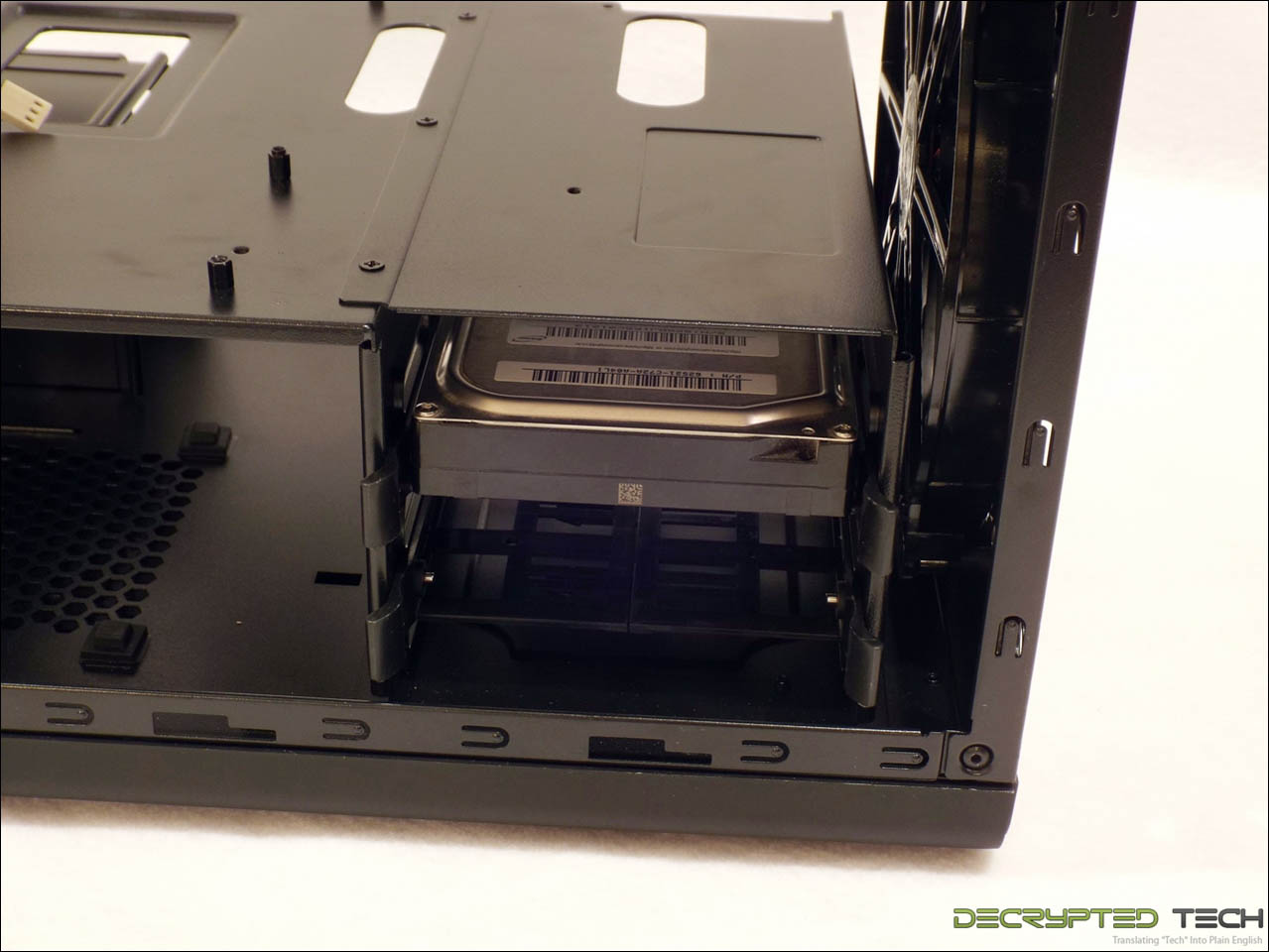 |
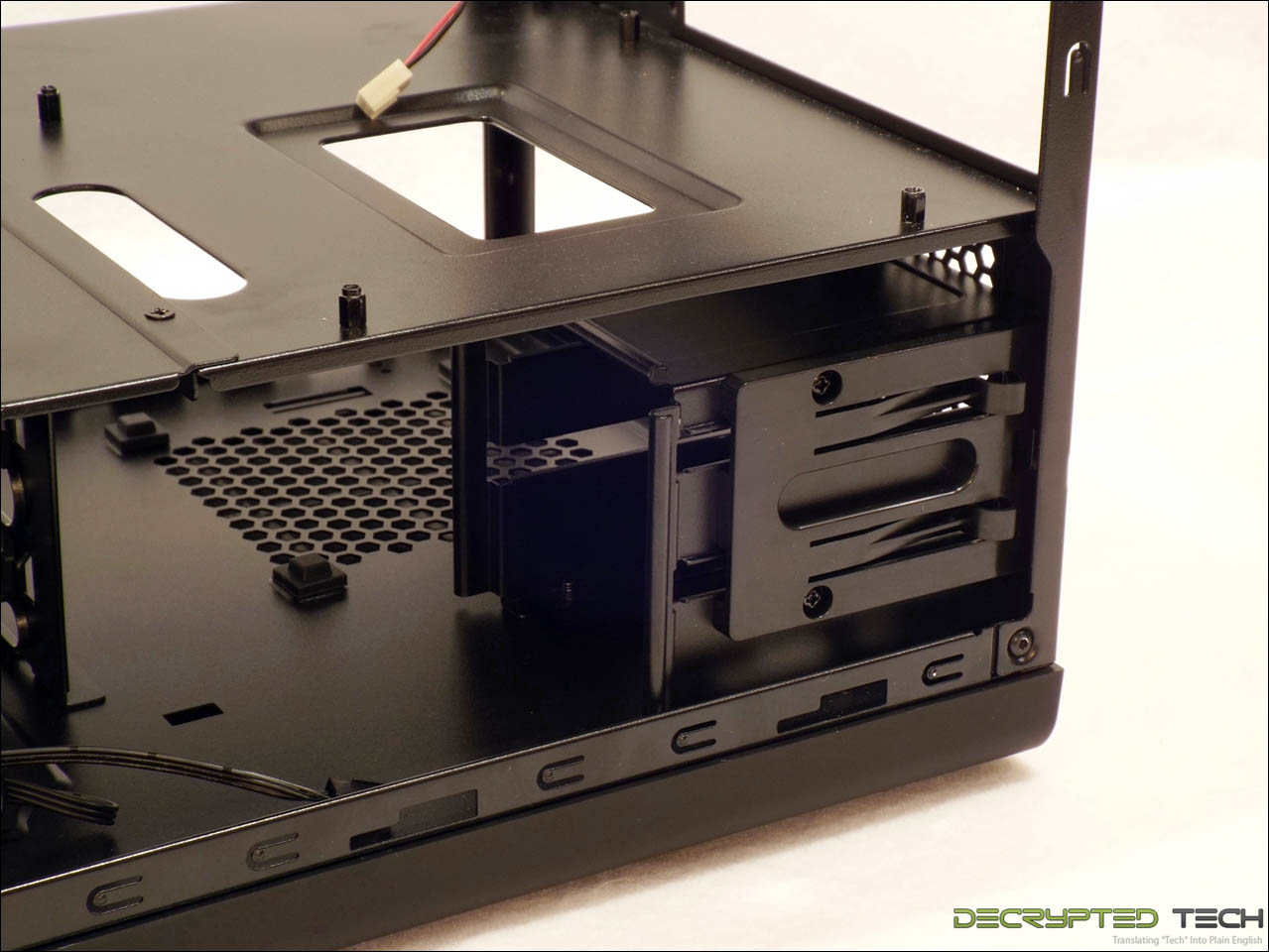 |
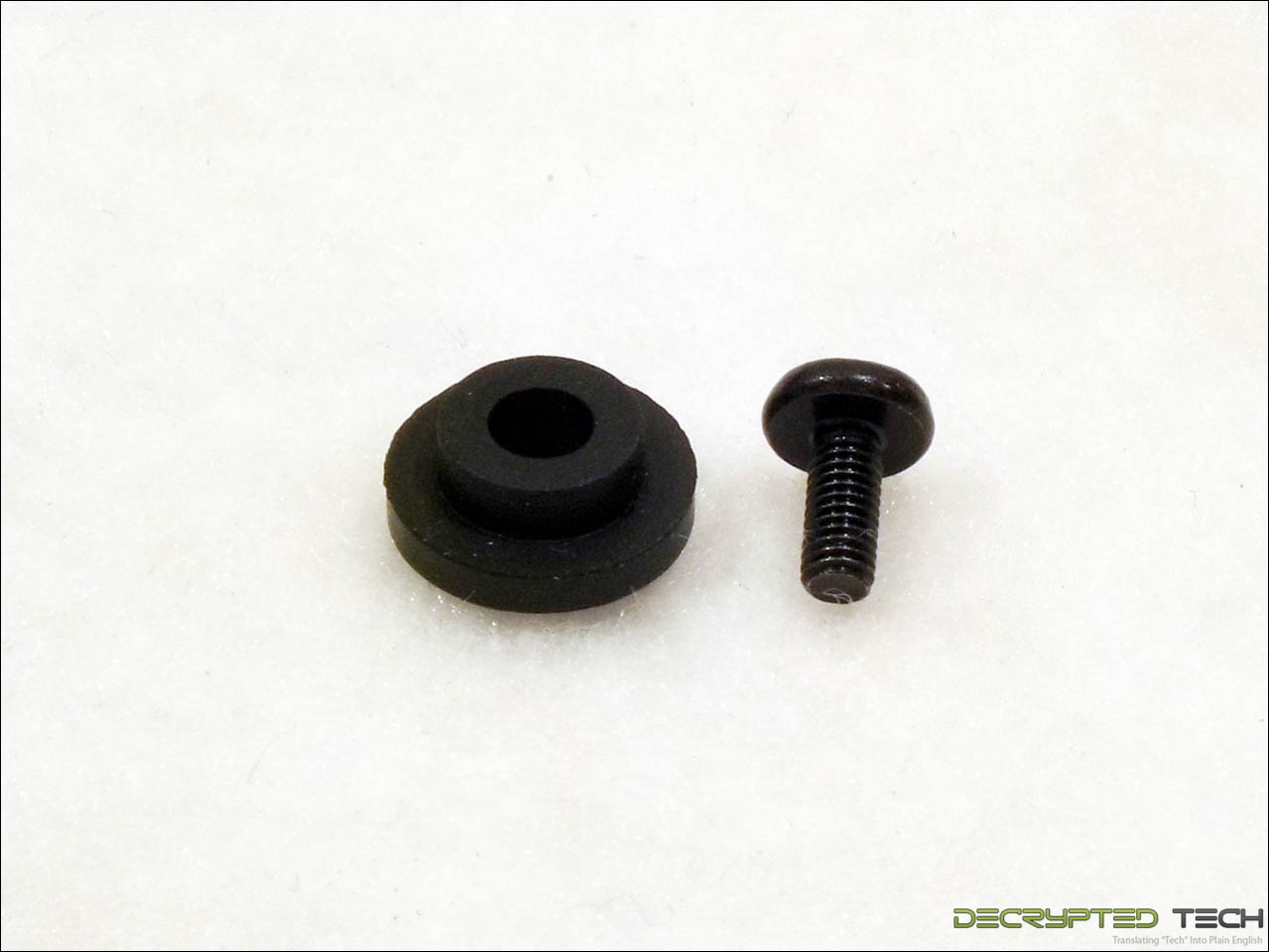 |
On the right side of the case at the rear is another set of drive bays, this one designed to hold up to two 2.5” drives. No cradles are used in this case though. Screws are mounted to the sides of the drive with the included rubber guides and the drive is clicked in place in the bay afterward. This is a surprisingly simple and secure mounting method.
Just on front of this 2.5” bay is a space that isn’t designed to be used to house any hardware. It may look like wasted space at first, but it is conveniently placed right where all of those cables on the right-hand panel are when it is in place. This space is the only thing that might make cable management in this case… manageable. It should also be noted that the entire front section of the motherboard tray and the front 3.5” hard drive bay can be removed, making for a lot more room inside the case.
Assembly:
When I first started to put the test system into the Steam Castle I ran into a problem almost immediately. None of the three power supplies that I have available to me would fit. Looking closer at the specifications on the Steam Castle, it states a length limit of 160mm. Turns out they were serious. When I emailed Deepcool about the dilemma they offered to send one of their power supplies that was within the design limits of the case. They also sent a couple of other pieces to test out in the case to see how they fit and how easy they were to work with. While this isn’t a review on these pieces, I do want to give a quick look at each of them, as each has its own points and each will be installed in the case being tested.
PSU: DQ750 Quanta modular. This is a good-looking unit, with an interesting pebbled finish. More importantly, it comes with flat modular cables and it’s 160mm long. Putting out 62 amps in a single 12-volt rail, it should be more than enough for whatever system we can squeeze into the Steam Castle.
 |
 |
 |
APU cooler: Maelstrom 240 closed-loop liquid cooling system. While very similar to most all-in-one systems on the market today, the Maelstron 240 comes with two of Deepcool’s better-looking 120mm fans, and the Deepcool logo is illuminated from within by a pulsating white LED. I was glad to see this in the care package from Deepcool, as I was interested to see how well it fits in this small chassis. I was pleasantly surprised to find a 4-way PWM fan hub included with the Maelstrom also.
 |
 |
 |
VGA cooler: Dracula 7970. I had mentioned to the folks at Deepcool previously that I had planned to use a Sapphire HD7970 video card in this build, as I wanted to test its usability with a larger card, so they included the Dracula 7970 cooler as well. This is excellent, since this cooler is absolutely huge, and will be an even better test of the case and installation potential. Since the Dracula doesn’t come with any fans they also sent some of their UF120R 120mm fans. I’ve used these before and have been thoroughly impressed. These fans are heavy, quiet and move quite a bit of air.
 |
 |
 |
 |
 |
Ok, back to the case at hand. For the initial test build the following components were used:
ASRock 960GC-GS FX micro-ATX motherboard
AMD Phenom II 1100T CPU
2 x 4GB Corsair Dominator DDR3 RAM
Deepcool Lucifer CPU cooler
Corsair Neutron 120GB SSD
Deepcool DQ750 Quanta 750 PSU
In the first build, all of the drive bays were left in place to see how the system would work out with these two huge air coolers installed.
The Lucifer was mounted to the motherboard outside the case by necessity.
Happily the assembly slid right in, even with the upper internal bays in place.
The PSU slid neatly into place, though all of the optional cables that would be needed had to be connected first and pulled through when it was installed. There is no room between the front of the PSU and the lower drive cage for connecting or maneuvering cables.
I was even able to install the 7970 card with the enormous Dracula cooler on it.
 |
 |
As mentioned, the Dracula does not come with any fans. It does come with a very sturdy extruded aluminum fan mounting bracket that allows tremendous flexibility in fan choice and mounting options. I can think of several times that a bracket like this would have come in *very* handy.
Unfortunately, there was not enough room between the outer edge of the Dracula and the side panel to mount the fans. Time to move to plan B.
After removing the video card, motherboard and both of the upper drive bays, I pulled off the Lucifer cooler and installed the pump/block of the Maelstrom and reinstalled the motherboard. Installation was as simple as I had hoped, though one of the tubing elbows did get in the way of one of the mounting nuts, requiring the use of a small screwdriver to tighten it up. With the block installed I attempted to mount the radiator with the tubing end toward the front of the case. Unfortunately the small extension on that end of the radiator didn’t allow the mounting holes to line up. Turning the radiator around solved the mounting issue and the tubing actually looks better like this I think. I have to say I like the red striped on the fans also.
 |
 |
Having gotten the gigantic air cooler out of the way, I remounted the fans onto the Dracula fan bracket horizontally so they would clear the side panel.
It worked, mostly. I was only able to use a single fan, as the rear fan hit the tubing on the radiator.
 |
 |
In the end it all went together very well, though I was lucky not to have many cables to deal with. The 4-port PWN fan hub provided with the Maelstrom was a life-saver, as it allowed me to tie back the brightly-colored 3-pin fan cables that came with the Steam Castle, and the motherboard’s lack of a USB 3.0 header kept me from having to route that thick cable onto the side of the board closest to the window. While I’m sure there is room enough to get the job done well, I’m glad I didn’t have to do it. Overall, for having such a small area, the Steam Castle is fairly easy to work with. As I mentioned, it could be much worse depending on your hardware, but with the empty space to the right of the lower drive cage, cable management is possible.
Modding:
I mentioned a couple of things earlier regarding modding. There are two kinds of cases that appeal to me as a modder: blank slates like many from Lian Li, and the exact kind of crazy I see here with the Steam Castle.
 |
 |
 |
Inside the front panel, we can see that those silver stacks on the front corners are only held in with tabs. Easily removable for modding. The upper mesh on the front panel is also easily removed by bending out the tabs. Personally, I would love to put a couple of vertical cylinder reservoirs in these corners with some good lighting and bubbles. If I had to have an internal optical drive bay, I would also cut off the mounting tabs on the 5.25” drive bay cover and shave the sides down just enough to slide into the hole freely and mount it to the front of the drawer of the optical drive. Done properly it would be nearly invisible. A small hole in one corner (both corners to maintain the symmetry) would allow the eject button to be accessed with a paper clip. A hassle? Yes, but I don’t use the optical drive all that much, and it would be worth it to maintain the front face appearance. Obviously an external drive would be another option but they are not for everyone.
 |
 |
 |
Looking at the underside of the top panel shows the power junction for the LED panels under each of the vent grills, and shows that these grills are easily removed as an assembly with a Phillips screwdriver. This opens up any number of possibilities with these openings, from fans to reservoirs, to some off-the-wall caps for the holes with mounts for a huge radiator and tubing. There really is a lot of room here for anything the modder wants to do.
 |
 |
 |
If you like the vents but want to do something with them, they are also easily broken down into their parts, with the backs held on with tabs and the clear diffuser for the LED held onto that piece with tabs of its own. They’re fairly stiff, so care should be taken not to break any but I managed to disassemble the entire thing without incident in fifteen minutes. Looking inside the lens at the LED board you can see even that comes off with a single screw. With power to this area built into the case with handy manual adjustment not only of power level but circuit via the color-changing switch, these could be turned into any number of things by the electrically-minded modder.
Conclusion:
The Steam Castle micro-ATX case from Deepcool is nothing if not original. It’s one of those cases that I enjoy that people will either love or hate; there is no middle ground here. Speaking purely in a functional sense, it works and without too much trouble. It has some drawbacks, most notably the placement of the controls and input ports on the right side of the case, but that’s the point where function gives way to form. At that point it’s really up to the end user to decide if the appearance of the case is worth dealing with that issue. This is a subjective choice and I leave it to you to make.
Personally, I love it. The size and appearance are more than enough to overcome the small drawbacks. I’m glad I was sent the black version as it turns out the other options (it comes in red, white and yellow also) do not come with the gorgeous satin rubber finish the black option has. While this makes sense from a marketing standpoint, as those colors are really supposed to stand out and a glossy finish helps that, I love the soft finish on the black version. Just touching it feels awesome.
With a list price of $99 at the time of this writing, I think the Steam Castle case from Deepcool is a great buy. It’s unique, it’s quiet, it’s small and it’s functional. If you’re on the side of the fence that likes the way it looks, I can recommend it without reservation. I hope to see many mods of this case in the future.
As much as I dislike judging on appearance, a case like this leaves little choice. I like it myself, and because of that, and the feature set it has at the price point it’s at, I’m giving the Steam Castle case from Deepcool our Silver Key award. I can’t wait to see what they come out with next.
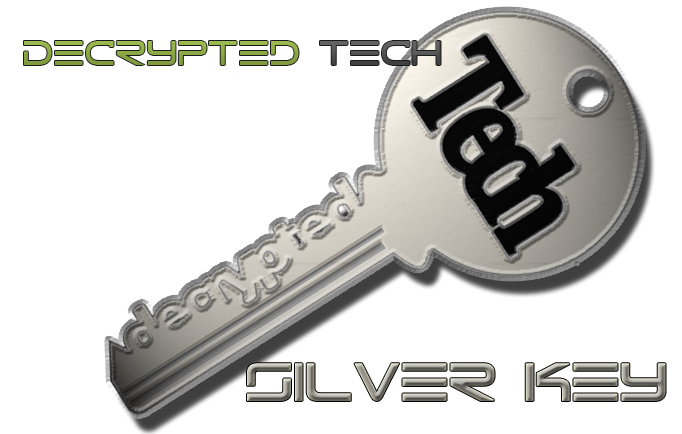 |
Tell us what you think in our Forum

